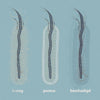
Dry, porous, or damaged? Get the right hair diagnosis
3 min reading time

3 min reading time
Learn the difference between dry, porous, and damaged hair . Discover how to diagnose and treat it professionally.
Making the correct diagnosis: dry, porous or damaged?
In professional hair care, diagnosis is the starting point of every treatment plan . Many clients say, "My hair is dry." But dry, porous, and damaged don't mean the same thing. Each type of problem has a different cause, structure, and solution. A proper analysis determines whether the hair needs moisture, protein, or reconstruction .
1. Dry hair – lack of hydration
Dry hair means that the cortex does not contain enough moisture or the cuticle is too open to retain water.
✔ Causes: Over-washing, harsh shampoos, sun, cold air, heat from styling tools.
✔ Symptoms: Hair feels rough, lacks shine, frizzes quickly.
✔ Solution: Hydrating treatments with hyaluronic acid, panthenol, aloe vera or glycerine .
Professional advice: Combine hydration with a pH-balancing product to close the scales.
2. Porous hair – open cuticle and loss of structure
Porous hair is hair that absorbs and loses too much water – a sign of structural damage to the cuticle.
✔ Causes: Chemical treatments (bleach, colour, keratin, straightening), excessive heat.
✔ Symptoms: Uneven color absorption, hair dries slowly, feels rough and irregular.
✔ Solution: Treatments with amino acids, ceramides and light oils to reseal the cuticle.
Professional advice: Use an acidic sealer (pH 4.5–5.0) after each color treatment to correct porosity.
3. Damaged hair – internal weakening of the cortex
Damaged hair is hair in which the keratin bonds (disulfide bonds) have been broken. This occurs deep within the hair fiber.
✔ Causes: intensive chemical or thermal stress.
✔ Symptoms: breakage, split ends, loss of elasticity, hair that no longer falls into shape.
✔ Solution: Restorative treatments such as Hair Botox, Bioplastia, Plex systems or protein-rich masks with amino acids.
Professional advice: always repair from the inside out – first structure, then shine.
4. The differences under the microscope
Under microscopic analysis one can clearly see:
✔ Dry hair – closed but dried out cuticle.
✔ Porous hair – open cuticle with holes in the lipid layer.
✔ Damaged hair – broken or missing keratin bonds in the cortex.
Professionals can recognize this visually with a magnifying glass or digital hair analysis camera.
5. Diagnosis in practice – step-by-step plan for hairdressers
1️⃣ Observation: Check shine, color, texture, and elasticity.
2️⃣ Touch test: rub between your fingers – does it feel rough, stiff, or soft?
3️⃣ Elasticity Test: Gently tug on a wet hair strand – does it break or stretch too far?
4️⃣ Porosity Test: Immerse in water – sinks (high porosity) or floats (low porosity)?
5️⃣ Treatment plan: combine hydration, nutrition and reconstruction according to the diagnosis.
6. Combinations and misunderstandings
Many hairs exhibit multiple problems at once – dry and porous, damaged and dehydrated.
✔ Dry + porous → moisture + lipids.
✔ Dry + damaged → moisture + protein.
✔ Porous + damaged → amino acids + keratin + sealing.
Professional insight lies in recognizing the priority : always recovery first, then care.
Conclusion: Real care starts with analysis, not with product
A shampoo or mask is only effective if it matches the diagnosis. Professional hair analysis distinguishes the expert from the amateur. In the PRO HAIR Academy, we learn to see, feel, test, and treat with structural knowledge.